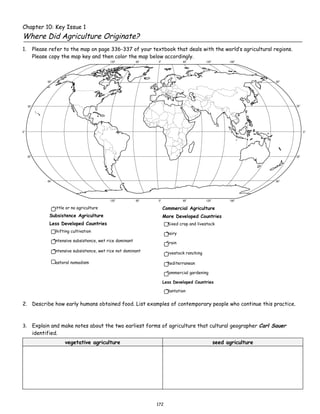
Chapter 10 key isssue 1
- 1. Chapter 10: Key Issue 1 Where Did Agriculture Originate? 1. Please refer to the map on page 336-337 of your textbook that deals with the world’s agricultural regions. Please copy the map key and then color the map below accordingly. Little or no agriculture Commercial Agriculture Subsistence Agriculture More Developed Countries Less Developed Countries Mixed crop and livestock Shifting cultivation Dairy Intensive subsistence, wet rice dominant Grain Intensive subsistence, wet rice not dominant Livestock ranching Pastoral nomadism Mediterranean Commercial gardening Less Developed Countries Plantation 2. Describe how early humans obtained food. List examples of contemporary people who continue this practice. 3. Explain and make notes about the two earliest forms of agriculture that cultural geographer Carl Sauer identified. vegetative agriculture seed agriculture 172
- 2. 4. The biggest difference between agriculture in MDCs and LDCs is the type of farming that is practiced. In More Developed Countries, most of the farming is commercial agriculture, while in Less Developed Countries most of the farming is subsistence agriculture. Complete the chart below summarizing the main differences between the two. subsistence agriculture (in LDCs) commercial agriculture (in MDCs) purpose of farming percentage of farmers in the labor force use of machinery farm size relationship of farming to other businesses 5. What did Derwent Whittlesey create in 1936 that is still used extensively toady? 6. Summarize the conclusions that Whittlesey came to in his studies about climate and agriculture. 7. Refer to the climate zone and agricultural maps (p.336-337) and identify any anomalies in the relationship between climate and type of agricultural practices, or in the type of agriculture and the designation of countries in the MDC or LDC classification, eg: plantation farming (characteristic of LDCs) in Australia (a MDC). Fold the page at the dotted line and then glue this part of the page into your notebook.